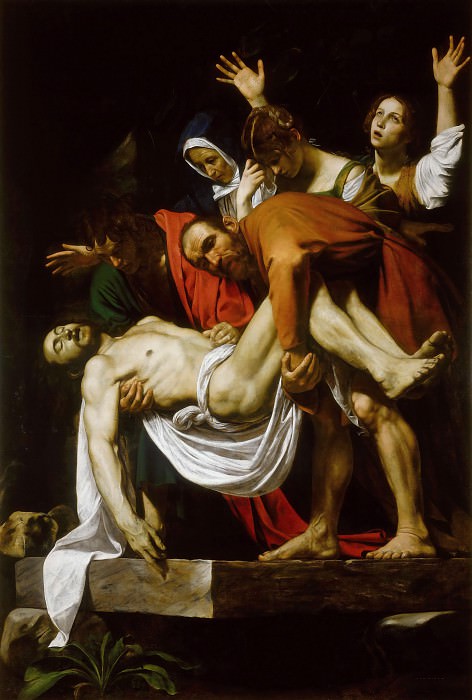Entombment Michelangelo Merisi da Caravaggio (1571-1610)
Michelangelo Merisi da Caravaggio – Entombment
Edit attribution
Download full size: 3504×5200 px (3,3 Mb)
Painter: Michelangelo Merisi da Caravaggio
Location: Vatican Museums (Musei Vaticani), Vatican.
Ever since Michelangelo Merisi da Caravaggio became the personal painter of Cardinal Francesco del Monte, he began to receive many commissions, including religious subjects. One such painting, entitled The Sepulchration, he painted for the Roman temple of Santa Maria della Valicella. It is considered one of the best of the artist’s work. In this picture, as in the other paintings of Caravaggio with religious themes, there is characteristic for the artist’s contrast of light and darkness.
Description of Michelangelo Merisi da Caravaggio’s painting The Posing in the Coffin
Ever since Michelangelo Merisi da Caravaggio became the personal painter of Cardinal Francesco del Monte, he began to receive many commissions, including religious subjects. One such painting, entitled The Sepulchration, he painted for the Roman temple of Santa Maria della Valicella. It is considered one of the best of the artist’s work.
In this picture, as in the other paintings of Caravaggio with religious themes, there is characteristic for the artist’s contrast of light and darkness. Against the background of gloomy and impenetrable darkness stands a group of people - in the foreground John and Nicodemus are holding the body of Christ, with the intention of lowering it into a stone coffin. Behind them are Jesus’ mother, Mary Magdalene and another Mary.
The young Mary is frozen in a silent cry, raising her hands to heaven, her hair sticking out in different directions-apparently she tore it up in wailing. Mary Magdalene’s head is mournfully lowered; he hides his tears, worrying over his loss. Jesus’ mother does not weep or shout; she stares silently at her son’s face, knowing she will never see him again. The men’s faces are focused and mournful.
John frowns at the lifeless face of his Master, while the strong and stout Nicodemus looks down at the bottom of the tomb, straining under the weight of Jesus’ body. Christ’s body is devoid of any cadaverous hues, it is pale, as if deprived of all the colors of life.
The composition of the Entombment is structured in such a way that the viewer becomes involuntarily part of the picture. The stone tomb in which they want to put Christ, one of the corners turned toward the viewer - a corner as if to break the thin barrier between the world of the picture and ordinary reality. The impression is intensified by the sharp elbow of Nicodemus holding Jesus by the feet. They seem to want to convey the immovable body of Christ to whoever is looking at the painting.
Кому понравилось
Пожалуйста, подождите
На эту операцию может потребоваться несколько секунд.
Информация появится в новом окне,
если открытие новых окон не запрещено в настройках вашего браузера.
You need to login
Для работы с коллекциями – пожалуйста, войдите в аккаунт (open in new window).














COMMENTS: 3 Ответы
В чем новаторство Караваджо как гения?, ведь даже существует такое направление как караваджизм. Скоро я дам личную оценку согласно далианской таблице
Моя оценка творчества Караваджо. Высший бал-20. Техника 15, Вдохновение 19, Цвет 15, Сюжет 16, Гений 20, Композиция 20, Оригинальность 19, Тайна 18, Подлинность 20. У С. Дали на 1 месте Вермеер, далее Рафаэль и Веласкес. Как можно в общем охарактеризовать творчество Караваджо. Он первый стал применять очень тёмный грунт. Почти все картины на чёрном фоне, что оказало большое влияние на Рембандта. В свою очередь этот прием перенял Караваджо у да Винчи. Ну и самым главным коньком можно считать то, что он первый широко стал использовать рисование с натуры какая она есть без прикрас, что обескураживало современников. Своей натуралистичностью он оказал сильное влияние на настоящее и будущее поколение. Также масштаб полотен вызывает уважение, гений однозначно.
#CharverseAI предоставляет интровертам среду, свободную от суждений, где они могут практиковать социальное взаимодействие и укреплять уверенность.
You cannot comment Why?